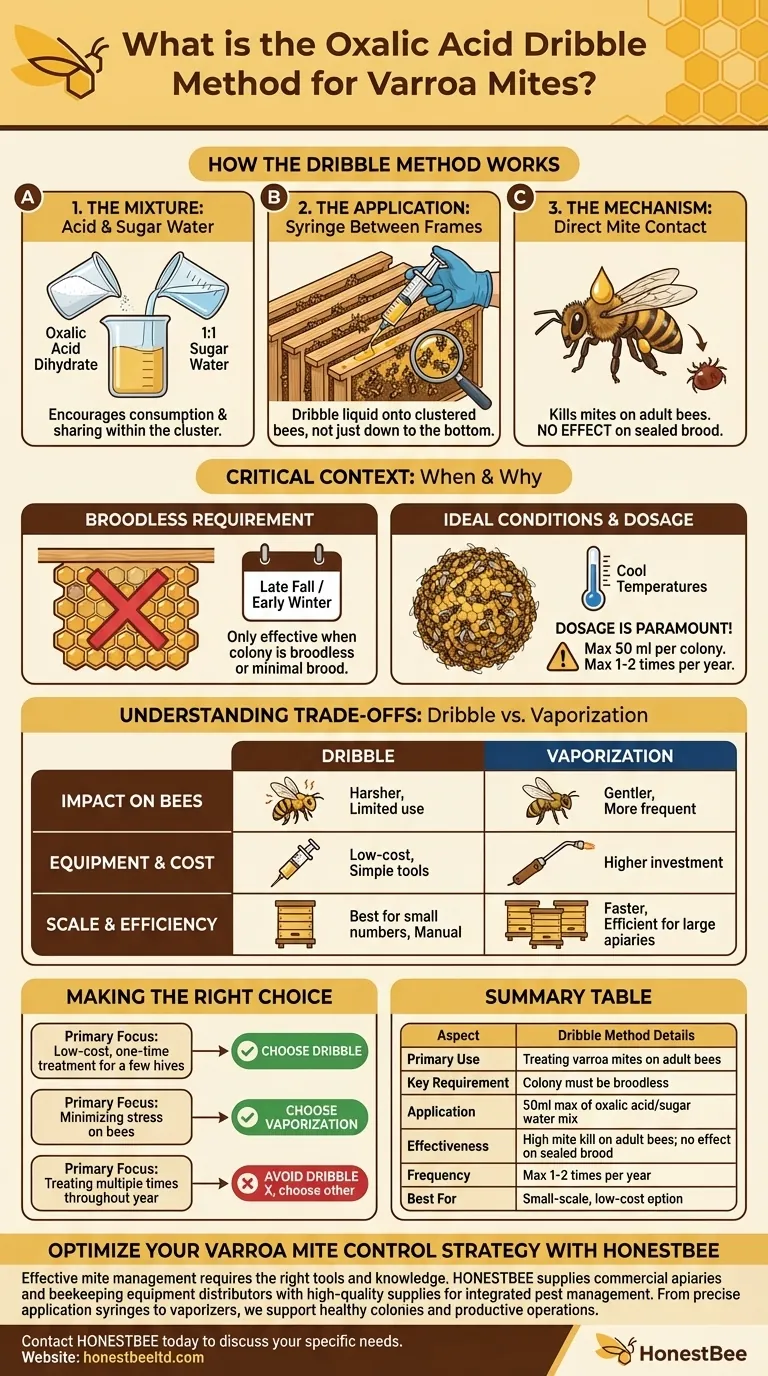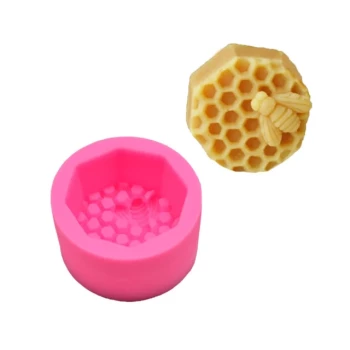The oxalic acid dribble method is a technique for treating varroa mites where a solution of oxalic acid and sugar water is trickled directly onto the bees. This liquid mixture is applied between the frames of a hive using a large syringe. Its effectiveness relies on direct contact and the subsequent sharing of the solution among the bees within the cluster.
The dribble method is a low-cost, effective mite treatment for colonies that have no sealed brood. However, its harshness on the bees' outer cuticle means it must be used sparingly and with precise dosage, making it a specialized tool rather than a routine treatment.

How the Dribble Method Works
The dribble method is a straightforward process that relies on a specific mixture and application technique to achieve a high mite kill on adult bees.
The Mixture: Acid and Sugar Water
The treatment solution consists of oxalic acid dihydrate dissolved in warm 1:1 sugar water. The sugar serves a critical purpose: it encourages the bees to consume the solution and share it with others through grooming and contact, maximizing its distribution throughout the hive cluster.
The Application: Syringe Between the Frames
Using a syringe for accuracy, the beekeeper applies the solution directly into the spaces between the frames. The goal is to dribble the liquid onto the bees that are clustered together. A slow, steady application ensures the solution coats the bees rather than just running down to the bottom board.
The Mechanism: Direct Mite Contact
This method kills varroa mites that are physically on the adult bees. When a mite comes into contact with the oxalic acid solution on a bee's body, it is killed. It is a direct contact treatment and has no effect on mites sealed inside brood cells.
The Critical Context: When and Why to Dribble
Proper timing and hive conditions are not just recommendations for the dribble method; they are essential for its success and for the safety of the colony.
The Broodless Requirement
Oxalic acid, whether dribbled or vaporized, cannot penetrate capped brood cells. Therefore, the dribble method is only effective when the colony is broodless or has a very minimal amount of brood. This typically occurs in late fall or early winter in cooler climates.
Ideal Conditions: Clustered Bees
The treatment works best when bees are in a tight cluster, which usually happens in cooler temperatures. A tight cluster ensures that the applied solution is efficiently spread from bee to bee. If the bees are too spread out, the solution is wasted and treatment efficacy drops significantly.
Dosage is Paramount
The total dose should not exceed 50 ml per colony. Overdosing can be highly detrimental to the bees. The limited application frequency—no more than twice a year—is due to the solution's harshness on the bees' protective outer layer, or cuticle.
Understanding the Trade-offs: Dribble vs. Vaporization
The dribble method is one of two primary ways to apply oxalic acid, the other being vaporization. Each has distinct advantages and disadvantages.
Impact on the Bees
This is the most significant trade-off. The liquid solution in the dribble method is considered harsher on the bees than the crystal residue left by vaporization. This is why its use is strictly limited. Vaporization, being less stressful on individual bees, can be performed more frequently if needed.
Equipment and Cost
The dribble method is extremely low-cost, requiring only a syringe and the raw ingredients. Vaporization requires a higher initial investment in a specialized heating wand or vaporizer.
Scale and Efficiency
Dribbling is a manual, hive-by-hive process that is well-suited for beekeepers with a small number of hives. Vaporization is generally faster and more efficient for treating larger apiaries.
Making the Right Choice for Your Goal
To decide if the dribble method is right for you, consider your primary objective.
- If your primary focus is a low-cost, one-time treatment for a few hives: The dribble method is an excellent and effective choice during a winter brood break.
- If your primary focus is minimizing stress on the bees: Vaporization is generally considered the gentler of the two approved oxalic acid methods.
- If your primary focus is treating multiple times throughout the year: The dribble method is unsuitable; you must choose a different treatment like vaporization or other mite control products.
Ultimately, choosing the right varroa mite treatment means understanding it as a specific tool for a specific job.
Summary Table:
| Aspect | Dribble Method Details |
|---|---|
| Primary Use | Treating varroa mites on adult bees |
| Key Requirement | Colony must be broodless (e.g., late fall/winter) |
| Application | 50ml max of oxalic acid/sugar water mix dribbled between frames |
| Effectiveness | High mite kill on adult bees; no effect on mites in sealed brood |
| Frequency | Max 1-2 times per year due to harshness on bees |
| Best For | Small-scale beekeepers seeking a low-cost treatment option |
Optimize Your Varroa Mite Control Strategy with HONESTBEE
Effective mite management requires the right tools and knowledge. The oxalic acid dribble method is a powerful, cost-effective solution for specific scenarios, but successful beekeeping depends on a comprehensive approach and reliable equipment.
HONESTBEE supplies commercial apiaries and beekeeping equipment distributors with the high-quality supplies needed for integrated pest management. From precise application syringes for treatments like the dribble method to vaporizers for alternative oxalic acid application, we provide the durable tools that support healthy colonies and productive operations.
Let us help you strengthen your mite control protocol. Our wholesale-focused operations ensure you get the professional-grade equipment your business depends on.
Contact HONESTBEE today to discuss your specific needs and discover how our supplies can enhance your beekeeping success.
Visual Guide

Related Products
- Varroa Easy Check Mite Tester Kit Counter Alcohol Wash Jar
- Professional Bamboo Queen Isolation Cage
- Professional Plastic Queen Excluder for Modern Beekeeping
- Langstroth Screen Bottom Board for Beekeeping Wholesale
- Professional Galvanized Hive Strap with Secure Locking Buckle for Beekeeping
People Also Ask
- What are the steps to perform an alcohol wash test after collecting the bees? A Guide to Accurate Varroa Mite Counting
- What is the Varroa EasyCheck and its purpose? Streamline Your Hive Health Monitoring
- What are some popular methods to measure Varroa mite load in beehives? Compare Accuracy & Bee Safety
- Why is an alcohol wash preferred over powdered sugar rolls? For Accurate Varroa Mite Management
- How often should varroa mite checks be performed using the alcohol wash method? Optimize Your Apiary's Health



















